
The colorful new banknotes issued in Costa Rica.
If you’re planning on traveling to Costa Rica any time soon and you intend bringing the notes left over from your last trip, be aware that the old 1,000 and 2,000 colones (¢) bills issued prior to mid-2011 are no longer legal tender and that after December 31, 2012, the ¢5,000 and ¢10,000 bills will also cease to be accepted for everyday transactions.On August 27, 2012, the Banco Central de Costa Rica introduced the final denominations of a new family of banknotes, launched on June 20, 2011, with release of the ¢1,000 and ¢2,000 notes, plus a ¢20,000 bill. Introduction of the new “family” of six banknotes coincided with the 60th anniversary of the Banco Central, in San José.
The old series notes of any denomination will cease to be legal tender on December 31, 2012. After that date you can exchange ¢5,000 and ¢10,000 bills at banks for the equivalent new currency (but after May 1, 2013, only at the Banco Central).
Confused about what bills in your pocket are old and what’s new? Compare all the bills currently still in circulation here.
The new notes are striking for their bold colors and exquisite designs. The front of each of the six denominations depicts an important historical figure who has contributed to Costa Rica’s democracy. The reverse sides depict the country’s biodiversity, representative of six ecosystems, with iconic species of the ecosystem depicted.
Front: Braulio Carrillo Colina, Costa Rican President 1838-1842
Back: Dry forest ecosystem showing a guanacaste tree and a white-tailed deer.
Front: Costa Rican politician, lawyer, and educational reformer Mauro Fernández Acuña
Back: Coral reef ecosystem depicting a starfish, corals, and a Bull Shark.
Front: Alfredo Gonzales Flores, Costa Rican President 1914-1917
Back: Mangrove ecosystem depicting an arboreal crab and a White-faced monkey
Front: José María Figueres Ferrer, leader of the 1948 Revolution and three-time president (1948-49, 1953-58, and 1970-74)
Back: Rainforest ecosystem featuring a three-toed sloth
Front: María Isabel Carvajal, educator and novelist (nom de plume “Carmen Lyra”)
Back: High-mountain paramó ecosystem depicting a hummingbird
Front: Ricardo Jiménez Oreamuno, three-time president (1910-14, 1924-28, and 1932-36)
Back: Montane cloud forest ecosystem depicting a blue morpho butterfly
The notes, which were printed by French company, Oberthur Technologies, are also about as high-tech as currencies come, with state-of-the-art security features to guard against counterfeiting, including:
Made of a fabric-like yet dirt-and humidity-resistant polypropylene material that’s three times as durable as cotton fiber paper notes, they also include braille features for the blind, while the bills also uniformly increase in size according to value.
Oh, and don’t expect your taxi driver to have change for a ¢50,000 bill. It’s equivalent to US$100. In fact, don’t expect them to even accept anything above a ¢5,000. Many Costa Rica vendors are simply too concerned with theft, never mind the ability to make change for high-value bills.